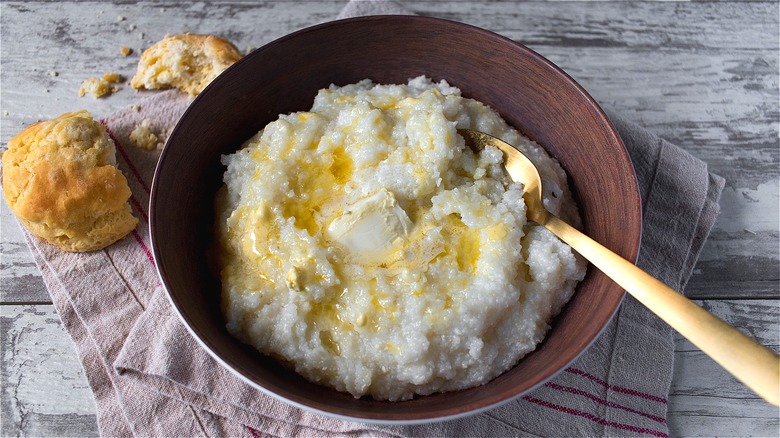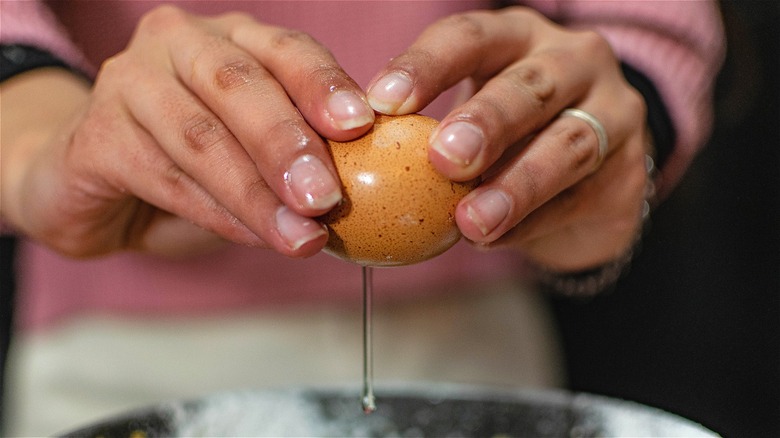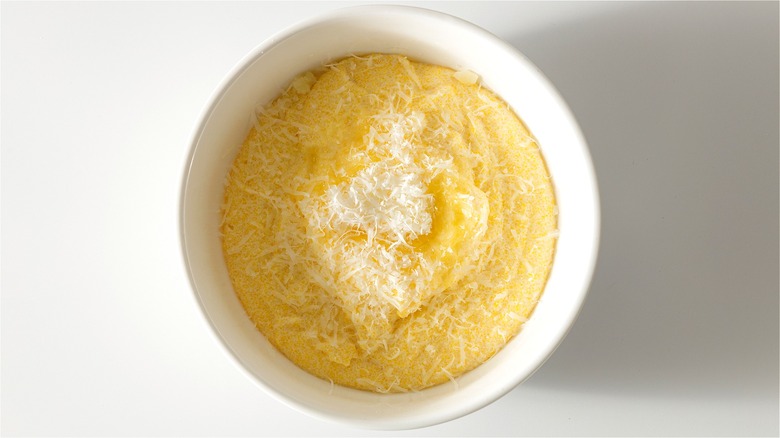A Raw Egg Is The Secret Ingredient To The Creamiest Bowl Of Grits Ever
Among the vast array of breakfast foods available worldwide, nothing fills and warms the belly more than a comforting bowl of grits. Grits are made from robust, savory corn known as dent corn and range in availability to include varieties like hearty stone ground grits, which are thicker and more hearty than instant grits, which have been partially cooked and processed. There are many reasons why you should consider grits for breakfast, but this ground corn's versatility may be a top selling point.
Next to serving grits as an accompaniment to your standard plate of eggs and bacon, you can transform this simple meal into an ultra-satisfying stand-alone dish in several ways. Next to making your grits extra creamy by preparing them with milk instead of water, why not use a raw egg to increase the savoriness of this fine ground corn? Once your grits have been cooked to completion over your stove, remove the pot from heat and quickly crack an egg directly into your steaming grits, stirring until the egg has been fully incorporated. In no time, you'll have perfectly luscious grits plus an extra dose of protein. While this may sound good in theory, you may feel slightly apprehensive about adding a raw egg to your morning meal. Though, does this last-minute egg addition stay raw upon consumption?
How raw egg transforms your next pot of grits into an ultra-creamy dish
Now that you know you can make grits more enjoyable with the addition of a raw egg, you might be ready to replace your usual warm and nutty cinnamon breakfast quinoa. If you're slightly worried about the consistency of your grits being overly laden with an uncooked, runny egg texture, the good news is your freshly cooked breakfast will slowly and gently cook your egg after it has been added to the pot. Just think of how your favorite pasta carbonara is made; rest assured, knowing the steam and heat from your freshly cooked grits will evenly work the egg into a custard-like sauce.
Before you attempt to upgrade your next batch of grits, you should follow a few steps to ensure ideal creaminess. To avoid your grits from turning clumpy, let your raw egg come to room temperature before adding. Once your grits are fully cooked, remove the pot from heat and add the raw egg, stirring continuously until every last bit has been incorporated. Even though you may be tempted to add the egg as your grits finish cooking, to achieve ultra-creamy grits with a uniform consistency, wait until your pot is completely off the heat to avoid overtly cooking this protein-rich addition. If you're still apprehensive about cracking an egg into your next morning meal, there are several other ways to increase the creaminess of your next pot of grits.
Raw eggs aren't the only way to elevate a steaming pot of grits
Instead of cracking an egg directly into your next pot of grits, why not add a soft-boiled or fried egg? If you like the convenience of using raw eggs, crack one into your pot toward the end of the suggested cooking time and cover without stirring. After a few minutes, stir the eggs, creating a tightly packed scrambled snack in your pot of cream-like corn.
Eggs aside, if you're looking for more ways to make creamier grits, you may want to consider preparing this warm and savory breakfast with a bit of milk or heavy cream. Replacing a portion of the suggested cooking water with your favorite liquid dairy product makes your grits apt to turn out extra creamy. To make your grits even more luscious and savory, fold some of your favorite grated cheese into hot grits for an ultra-satisfying twist. Next to making jalapeño cheese grits, you may want to go in the opposite direction and use a bit of cream cheese to give your grits a supreme velvety texture. There are plenty of ways to upgrade the consistency of your next corn-based breakfast bowl. While you can always use milk and cheese to give your grits both veritable texture and flavor boosts, for a quick yet subtle way to elevate your next hearty breakfast, consider using a raw egg.


